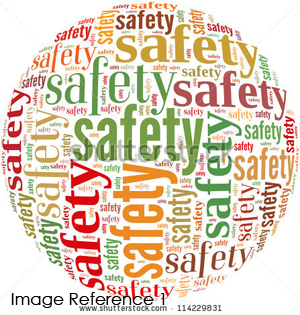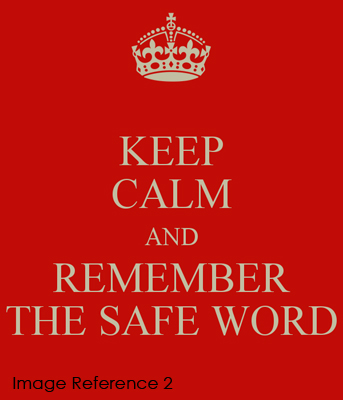Choose Your Safeword

Choosing a good safeword or set of words does take some consideration. It is important that you establish with your partner what your safeword means. Are you setting a word for full stop of the scene? Or something for a break? It is also important to remind your partner of the established safewords and associated meanings at the beginning of each session so they are fresh in mind (Blaze, 2010).
Finding the Right Words
Aside from choosing what your safeword should communicate to your partner, selecting the word itself can be important. A good signifier of safety is also one that unlikely to be used in a normal play scene. There should be no confusion as to if the safeword is being used or if it is normal conversation occurring within the scene. Words that are too long or complicated can be hard to remember, especially in the heat of the moment. The word should also be distinct sounding; homonyms (such as "bare" and "bear") that could be confused should be avoided. In a play scenario where endorphins are high and everyone may not be thinking clearly, anything that can be confused is likely to be (DrHGuy, 2006). Your choice should also be one that both participants feel comfortable with remembering. If you do find yourself in a position where you cannot remember what was picked, using "Safeword" can always be a good fall back.
Safewords for Public Play
If attending a public play party, it can be advantageous to use the established house safewords, particularly if you do not have a set of your own that you and your partner are comfortable with. This will attune you to the use of these words for any partners that prefer the community established designators. It also alerts the dungeon masters, and everyone else present, if you have called out your need to break or end the scene in a public play space; this can be a safer option if playing with a new and unfamiliar partner (Thomas, 2010).
Nonverbal Ways to Communicate Safety

It is important to consider your safety when playing in scenarios that may impair or completely inhibit the bottom’s ability to speak. Non-verbal safewords are an excellent solution and can have a multitude of advantages. Aptly chosen visual or audio signals can be extremely effective in drawing attention and a creative non-verbal signal can add some artistic flare to your scene which can help draw in both participants and add to the tone of a scene. If you are playing in a scene where there is a danger of any loss of consciousness, a well-placed non-verbal sign can be the difference in time that averts danger. At a public play event I witnessed a scene in which the two players were working with water asphyxiation. The top had secured the bottom to a chair and was pouring water into a cover of burlap over the bottom’s face. The bottom had been given two large rope bondage rings, one for each hand. When the bottom needed a break, the rings were dropped; this also served as a visual and audio safeguard against any loss of consciousness.
Good non-verbal safewords are ones that are appropriate to the type of scene you are doing. A visual cue will not be helpful in a scene where the top is focused on an area of the bottom that the safe cue would not be in their line of sight, likewise an audio safeword would be ineffective if the bottom loses consciousness and unable to enact any motion the audio signifier may require (such as tapping or moving a noise maker). Be smart and choose something appropriate for the activity.
Play Safe
Playing safe and smart is a lot easier with established safewords and a clear discussion around consent. This discussion should definitely occur before you have your play scene, particularly if this partner is less familiar to you. Some established players argue that they no longer need to use a safety system as they know their partner well. This is one of the main controversies around safewords. Even if you have been with the same partner for a long time and you are very in sync with your partner, no matter how long you have been playing, having a safety system is a good idea. You and your partner should feel comfortable being able to set and use safewords, even if they are not needed.
Article References
A Submissives Journey. (2011). Establishing a "safe word". Retrieved 01 11, 2014, from A Submissives Journey: http://www.asubmissivesjourney.com/safe_word.html
BitchMedia. (2013). Thinking Kink: Safewords. Retrieved 04 02, 2014, from Bitch Media: http://bitchmagazine.org/post/thinking-kink-safewords-bdsm-sex-feminist-magazine-sexuality-media
Blaze, M. (2010, 04 22). Safe Word Ideas - for Dominatrix and sub. Retrieved 04 09, 2014, from Arena Blaze: http://www.arenablaze.com/article.php/safe-word-ideas
Clark-Flory, T. (2012, 01 28). When safe words are ignored. Retrieved 04 02, 2014, from Salon: http://www.salon.com/2012/01/29/real_abuse_in_bdsm/
DrHGuy. (2006, 06 02). 13 Mistakes To Avoid When Selecting A Safeword For BDSM Play. Retrieved 04 09, 2014, from Heck of a Guy: http://1heckofaguy.com/2006/06/02/urbane-skills-how-the-optimal-sub-avoids-suboptimal-safe-words/
Hunter, M. (2001). To Red or Not to Red. Retrieved 04 02, 2014, from A Submissive's Journey: http://www.asubmissivesjourney.com/safeword_red.html
Kinsey, K. (n.d.). Why You Should Use Safewords:. Retrieved 04 09, 2014, from Kate Kinsey: http://www.katekinsey.com/safewords.html
Lickerman, A. (2012, 11 11). The Magical Power Of "Safe" Words To Prevent Harm. Retrieved 04 09, 2014, from Psychology Today: http://www.psychologytoday.com/blog/happiness-in-world/201211/the-magical-power-safe-words-prevent-harm
lunaKM. (2009, 09 21). The Safety Disguise of Safewords. Retrieved 04 02, 2014, from Submissive Guide: http://www.submissiveguide.com/2009/09/safety-disguise-safewords/
lunaKM. (2009, 01 01). To Safeword or Not To Safeword. Retrieved 04 09, 2014, from Submissive Guide: http://www.submissiveguide.com/2009/01/to-safeword-or-not-to-safeword/
NotJustBitchy. (2013, 08 13). Safewords: they’re just words. Retrieved 04 09, 2014, from Not Just Bitchy: http://www.notjustbitchy.com/safewords-theyre-just-words/
Thomas. (2010, 07 01). The Annotated Safeword. Retrieved 04 02, 2013, from Yes means Yes: http://yesmeansyesblog.wordpress.com/2010/07/07/the-annotated-safeword/
Varrin, C. (1998). The Art of Sensual Female Dominance: A Guide for Women. New York: Citadel Press.
Will. (2013, 01 06). Why Safewords Are Not Safe. Retrieved 04 09, 2014, from BDSM: Things you Need to Know: http://thejourneyofwill.blogspot.ca/2013/01/why-safewords-are-not-safe.html
Wiseman, J. (1998). SM 101. Gardena, CA: Greenery Press.
Image References
Someone else's art deserves recognition! The images presented in this article were borrowed from the following places:
Header Image: Keeping it Kinky Original taken by Jen Elliot | Taken 2013
Image 1: http://thumb7.shutterstock.com/display_pic_with_logo/61243/114229831/stock-photo-safety-info-text-graphics-and-arrangement-concept-on-white-background-word-cloud-114229831.jpg | Retrieved April 9, 2014
Image 2: http://sd.keepcalm-o-matic.co.uk/i/keep-calm-and-remember-the-safe-word-1.png | Retrieved April 9, 2014